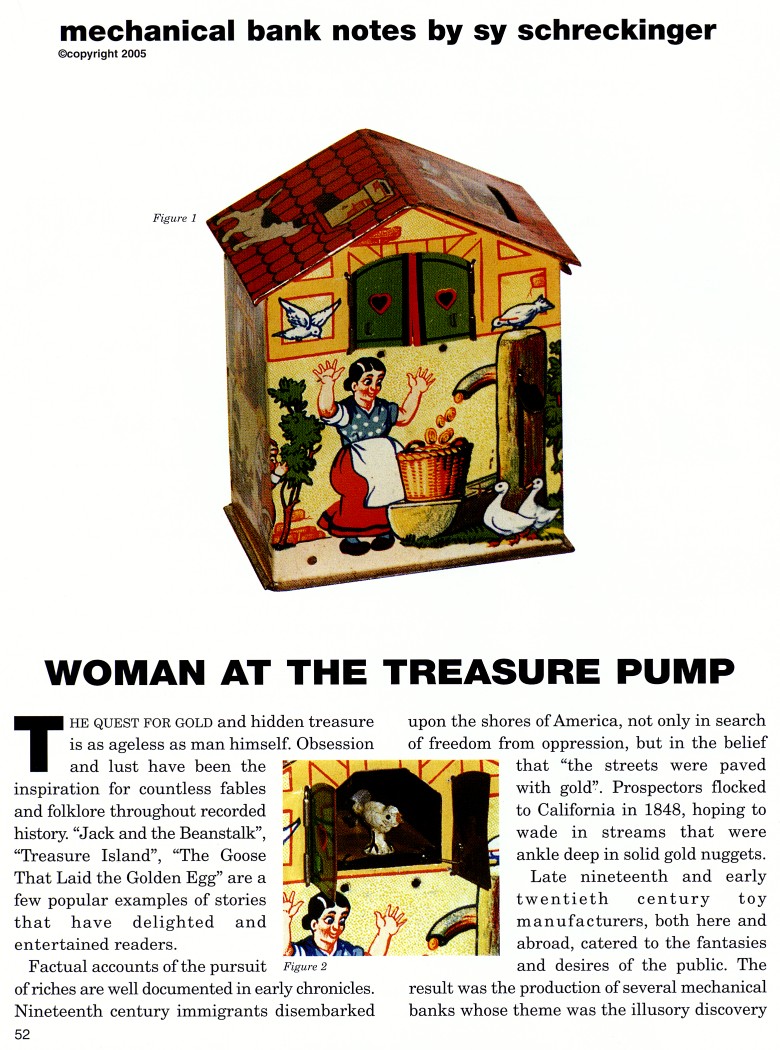|
Woman at the Treasure
Pump
by Sy Schreckinger – ANTIQUE TOY WORLD Magazine – April, 2005
The quest for gold and hidden treasure is as ageless as man
himself. Obsession and lust have been the inspiration for countless fables
and folklore throughout recorded history "Jack and the Beanstalk",
"Treasure Island", "The Goose That Laid the Golden Egg" are a few popular
examples of stories that have delighted and entertained readers.
Factual accounts of the pursuit of riches are well documented in early
chronicles. Nineteenth century immigrants disembarked upon the shores of
America, not only in search of freedom from oppression, but in the belief
that "the streets were paved with gold". Prospectors flocked to California
in 1848, hoping to wade in streams that were ankle deep in solid gold
nuggets.
Late nineteenth and early twentieth century toy manufacturers, both
here and abroad, catered to the fantasies and desires of the public. The
result was the production of several mechanical banks whose theme was the
illusory discovery of wealth. Notables include: "Old Aunt Dina and the
Fairy" (Antique Toy World,
September 1999 and
December 2001), "Presto
Bank" Penny Changes to a Quarter (ATW,
May 1993), and the subject of this
article, "Woman at the Treasure Pump", Figure 1. However, unlike "Aunt
Dina" and "Presto", which are banks that demonstrate the acquisition of
wealth through animation, "Woman at the Treasure Pump" indicates this
solely via a colorful illustration.
The facade of the mechanical featured in Figure 1 portrays a peasant
woman standing before a water pump. Her arms are raised and her face
reflects astonishment as she views the pump's dispensation of gold coins
in place of the anticipated water.
Action of the bank amusingly demonstrates the celebration of this
peasant lady's moment of good fortune. A Lincoln Head Cent or coin of
similar size is placed in the slot of the cottage roof. The coin remains
visibly in place. (Note: to avoid irreparable damage to the internal
mechanism, no coinage larger than a Lincoln Head Cent should be utilized.)
As the pump handle is depressed the coin drops into the bank and the green
shutter doors open, allowing a small, white bird to emerge (Figure 2). As
the bird appears, a chirping sound is emitted from within the bank.
Deposits are retrieved by opening a key lock, trap door style coin
retainer underneath the base of the bank.
Interestingly, the only other tin mechanical bank to utilize a
notably similar bellows- activated "chirper" is the "Crowing Rooster
Bank", Figure 3. This mechanical was manufactured by Keim and Company,
Nurnberg, Germany, circa 1935. Similarities between it and our subject
establish the possibility that this same company produced both.
Speculation is also based upon several other factors. Aside from their
internal chirping mechanisms, each utilizes a like internal coin
retainer/baffle; their subjects are situated in farm-related settings;
both mechanicals are decorated in simplistic, 1930's cartoon-style
illustrations; they both are constructed of lithographed tinplate; lastly,
each exhibits the wordage "D.R.G.M. MADE IN GERMANY" which designates
items manufactured in Germany from 1900 through 1938.
Unfortunately, to date, and to my knowledge, no documented patent
and/or manufacturing information related to "Woman at the Treasure Pump"
bank has been located. All that may be stated as fact is the mechanical
was produced in Germany sometime prior to 1939. The aforementioned letters
"D.R.G.M." exhibited on its side refer to an early German patent
designation, i.e. "Deutches Reichs Geshutzes Muster", meaning
insignificant item. The German government discontinued this stipulation
immediately prior to World War II.
"Woman at the Treasure Pump" is diminutive in size (Height: 4-1/16
inches; Width: 3-1/16 inches.) It is colorful and attractive in appearance
and a most desirable addition to a mechanical bank collection. It is quite
scarce, however, and at the present time I am aware of only four examples
in collections.
Hopefully, additional information will present itself to clarify
insubstantiality and dispel mere conjecture pertaining to this
mechanical's origins.
Acknowledgement: The fine example of "Crowing Rooster" (Figure 3) is in
the collection of Mr. Robert Weiss.
|


